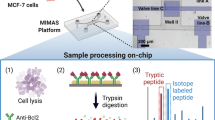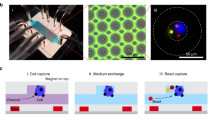Abstract
This study utilized a microfluidic mixer for the sample pretreatment of cell extracts for target protein quantification by mass spectrometers, including protein immunoprecipitation and protein enzymatic digestion. The time of sample pretreatment was reduced and thus the throughput of quantitative mutant proteins was increased by using the proposed method. Whole cell lysates of the cancer cell line HT-29 with gene mutations were used as the sample. The target protein BRAF was immunoprecipitated using magnetic beads in a pneumatic micromixer. Purified protein was then eluted and digested by trypsin in another two micromixers to yield peptide fragments in the solution. Using stable isotope-labeled standard as the internal control, wild-type and mutant BRAF proteins were quantified using mass spectrometry, which could be used for cancer screening. Compared with conventional methods in which protein immunoprecipitation lasts overnight, the micromixer procedure takes only 1 h, likely improving the throughput of mutant BRAF protein quantification by mass spectrometry.

Three micromixers were used to reduce the sample pretreatment time of cell extracts for target protein quantification by mass spectrometers, including protein immunoprecipitation, protein elution, and protein enzymatic digestion.








Similar content being viewed by others
References
Siegel R, Ma J, Zou Z, Jemal A. Cancer statistics, 2014. CA-Cancer J Clin. 2014;64(1):9–29. https://doi.org/10.3322/caac.21208.
Bray F, Jemal A, Grey N, Ferlay J, Forman D. Global cancer transitions according to the human development index (2008–2030): a population-based study. Lancet Oncol. 2012;13(8):790–801. https://doi.org/10.1016/S1470-2045(12)70211-5.
Hu S, Arellano M, Boontheung P, Wang J, Zhou H, Jiang J, et al. Salivary proteomics for oral cancer biomarker discovery. Clin Cancer Res. 2008;14(19):6246–52. https://doi.org/10.1158/1078-0432.Ccr-07-5037.
Ye B, Cramer DW, Skates SJ, Gygi SP, Pratomo V, Fu L, et al. Haptoglobin-α subunit as potential serum biomarker in ovarian cancer: identification and characterization using proteomic profiling and mass spectrometry. Clin Cancer Res. 2003;9(8):2904–11.
Davies H, Bignell GR, Cox C, Stephens P, Edkins S, Clegg S, et al. Mutations of the BRAF gene in human cancer. Nature. 2002;417:949. https://doi.org/10.1038/nature00766.
Johnson AS, Crandall H, Dahlman K, Kelley MC. Preliminary results from a prospective trial of preoperative combined BRAF and MEK-targeted therapy in advanced BRAF mutation-positive melanoma. J Am Coll Surg. 2015;220(4):581–93.e1. https://doi.org/10.1016/j.jamcollsurg.2014.12.057.
Xing M. BRAF mutation in thyroid cancer. Endocr Relat Cancer. 2005;12(2):245–62. https://doi.org/10.1677/erc.1.0978.
Kim HO, Kim BG, Cha SJ, Park YG, Lee TJ. Clinicopathologic significance of BRAF mutation and extracellular signal regulated kinase 1/2 expression in patients with a colorectal adenocarcinoma. Ann Coloproctol. 2015;31(1):9–15. https://doi.org/10.3393/ac.2015.31.1.9.
Wang Q, Chaerkady R, Wu J, Hwang HJ, Papadopoulos N, Kopelovich L, et al. Mutant proteins as cancer-specific biomarkers. Proc Natl Acad Sci U S A. 2011;108(6):2444–9. https://doi.org/10.1073/pnas.1019203108.
Carey KD, Garton AJ, Romero MS, Kahler J, Thomson S, Ross S, et al. Kinetic analysis of epidermal growth factor receptor somatic mutant proteins shows increased sensitivity to the epidermal growth factor receptor tyrosine kinase inhibitor, erlotinib. Cancer Res. 2006;66(16):8163–71. https://doi.org/10.1158/0008-5472.Can-06-0453.
Koperek O, Kornauth C, Capper D, Berghoff AS, Asari R, Niederle B, et al. Immunohistochemical detection of the BRAF V600E-mutated protein in papillary thyroid carcinoma. Am J Surg Pathol. 2012;36(6):844–50. https://doi.org/10.1097/PAS.0b013e318246b527.
Capper D, Preusser M, Habel A, Sahm F, Ackermann U, Schindler G, et al. Assessment of BRAF V600E mutation status by immunohistochemistry with a mutation-specific monoclonal antibody. Acta Neuropathol. 2011;122(1):11–9. https://doi.org/10.1007/s00401-011-0841-z.
Chen H, Hsiao Y-C, Chiang S-F, Wu C-C, Lin Y-T, Liu H, et al. Quantitative analysis of wild-type and V600E mutant BRAF proteins in colorectal carcinoma using immunoenrichment and targeted mass spectrometry. Anal Chim Acta. 2016;933:144–55. https://doi.org/10.1016/j.aca.2016.05.037.
Chen Y-T, Chen H-W, Domanski D, Smith DS, Liang K-H, Wu C-C, et al. Multiplexed quantification of 63 proteins in human urine by multiple reaction monitoring-based mass spectrometry for discovery of potential bladder cancer biomarkers. J Proteome. 2012;75(12):3529–45. https://doi.org/10.1016/j.jprot.2011.12.031.
Addona TA, Abbatiello SE, Schilling B, Skates SJ, Mani DR, Bunk DM, et al. Multi-site assessment of the precision and reproducibility of multiple reaction monitoring–based measurements of proteins in plasma. Nat Biotechnol. 2009;27:633. https://doi.org/10.1038/nbt.1546.
Kuzyk MA, Smith D, Yang J, Cross TJ, Jackson AM, Hardie DB, et al. Multiple reaction monitoring-based, multiplexed, absolute quantitation of 45 proteins in human plasma. Mol Cell Proteomics. 2009;8(8):1860–77. https://doi.org/10.1074/mcp.M800540-MCP200.
Wolf-Yadlin A, Hautaniemi S, Lauffenburger DA, White FM. Multiple reaction monitoring for robust quantitative proteomic analysis of cellular signaling networks. Proc Natl Acad Sci U S A. 2007;104(14):5860–5. https://doi.org/10.1073/pnas.0608638104.
Keshishian H, Addona T, Burgess M, Kuhn E, Carr SA. Quantitative, multiplexed assays for low abundance proteins in plasma by targeted mass spectrometry and stable isotope dilution. Mol Cell Proteomics. 2007;6(12):2212–29. https://doi.org/10.1074/mcp.M700354-MCP200.
Geiger T, Wisniewski JR, Cox J, Zanivan S, Kruger M, Ishihama Y, et al. Use of stable isotope labeling by amino acids in cell culture as a spike-in standard in quantitative proteomics. Nat Protoc. 2011;6:147. https://doi.org/10.1038/nprot.2010.192.
Anderson NL, Anderson NG, Haines LR, Hardie DB, Olafson RW, Pearson TW. Mass spectrometric quantitation of peptides and proteins using stable isotope standards and capture by anti-peptide antibodies (SISCAPA). J Proteome Res. 2004;3(2):235–44. https://doi.org/10.1021/pr034086h.
Gillette MA, Carr SA. Quantitative analysis of peptides and proteins in biomedicine by targeted mass spectrometry. Nat Methods. 2012;10:28. https://doi.org/10.1038/nmeth.2309.
Sandison ME, Cumming SA, Kolch W, Pitt AR. On-chip immunoprecipitation for protein purification. Lab Chip. 2010;10(20):2805–13. https://doi.org/10.1039/C005295G.
He M, Crow J, Roth M, Zeng Y, Godwin AK. Integrated immunoisolation and protein analysis of circulating exosomes using microfluidic technology. Lab Chip. 2014;14(19):3773–80. https://doi.org/10.1039/C4LC00662C.
McKenzie KG, Lafleur LK, Lutz BR, Yager P. Rapid protein depletion from complex samples using a bead-based microfluidic device for the point of care. Lab Chip. 2009;9(24):3543–8. https://doi.org/10.1039/B913806D.
Cheng G, Liu Y-L, Zhang J-L, Sun D-H, Ni J-Z. Lanthanum silicate coated magnetic microspheres as a promising affinity material for phosphopeptide enrichment and identification. Anal Bioanal Chem. 2012;404(3):763–70. https://doi.org/10.1007/s00216-012-6150-0.
Cheng G, Wang Z-G, Liu Y-L, Zhang J-L, Sun D-H, Ni J-Z. Magnetic affinity microspheres with meso-/macroporous shells for selective enrichment and fast separation of phosphorylated biomolecules. ACS Appl Mater Interfaces. 2013;5(8):3182–90. https://doi.org/10.1021/am400191u.
Seale B, Lam C, Rackus DG, Chamberlain MD, Liu C, Wheeler AR. Digital microfluidics for immunoprecipitation. Anal Chem. 2016;88(20):10223–30. https://doi.org/10.1021/acs.analchem.6b02915.
Cheng G, Hao S-J, Yu X, Zheng S-Y. Nanostructured microfluidic digestion system for rapid high-performance proteolysis. Lab Chip. 2015;15(3):650–4. https://doi.org/10.1039/C4LC01165A.
Liu Y, Lu H, Zhong W, Song P, Kong J, Yang P, et al. Multilayer-assembled microchip for enzyme immobilization as reactor toward low-level protein identification. Anal Chem. 2006;78(3):801–8. https://doi.org/10.1021/ac051463w.
Bao H, Chen Q, Zhang L, Chen G. Immobilization of trypsin in the layer-by-layer coating of graphene oxide and chitosan on in-channel glass fiber for microfluidic proteolysis. Analyst. 2011;136(24):5190–6. https://doi.org/10.1039/C1AN15690J.
Fan H, Chen G. Fiber-packed channel bioreactor for microfluidic protein digestion. Proteomics. 2007;7(19):3445–9. https://doi.org/10.1002/pmic.200700505.
Liu J, Lin S, Qi D, Deng C, Yang P, Zhang X. On-chip enzymatic microreactor using trypsin-immobilized superparamagnetic nanoparticles for highly efficient proteolysis. J Chromatogr A. 2007;1176(1):169–77. https://doi.org/10.1016/j.chroma.2007.10.094.
Li Y, Xu X, Yan B, Deng C, Yu W, Yang P, et al. Microchip reactor packed with metal-ion chelated magnetic silica microspheres for highly efficient proteolysis. J Proteome Res. 2007;6(6):2367–75. https://doi.org/10.1021/pr060558r.
Slovakova M, Minc N, Bilkova Z, Smadja C, Faigle W, Fütterer C, et al. Use of self assembled magnetic beads for on-chip protein digestion. Lab Chip. 2005;5(9):935–42. https://doi.org/10.1039/B504861C.
Sung-Yi Y, Jr-Lung L, Gwo-Bin L. A vortex-type micromixer utilizing pneumatically driven membranes. J Micromech Microeng. 2009;19(3):035020.
Cheng G, Zheng S-Y. Construction of a high-performance magnetic enzyme nanosystem for rapid tryptic digestion. Sci Rep. 2014;4:6947. https://doi.org/10.1038/srep06947.
Cheng G, Chen P, Wang Z-G, Sui X-J, Zhang J-L, Ni J-Z. Immobilization of trypsin onto multifunctional meso-/macroporous core-shell microspheres: a new platform for rapid enzymatic digestion. Anal Chim Acta. 2014;812:65–73. https://doi.org/10.1016/j.aca.2013.12.035.
Funding
The authors would like to thank the Ministry of Science and Technology of Taiwan and the Chang Gung Memorial Hospital for their funding support (105-2221-E-182-036-MY3, CMRPD2F0241, BMRPC01, CLRPD190018). This study was also supported by the “Molecular Medicine Research Center, Chang Gung University” from The Featured Areas Research Center Program within the framework of the Higher Education Sprout Project by the Ministry of Education (MOE) in Taiwan.
Author information
Authors and Affiliations
Corresponding authors
Ethics declarations
Conflict of interest
The authors declare that they have no conflicts of interest.
Additional information
Publisher’s note
Springer Nature remains neutral with regard to jurisdictional claims in published maps and institutional affiliations.
Electronic supplementary material
ESM 1
(PDF 486 kb)
Rights and permissions
About this article
Cite this article
Lin, YH., Chang, HY., Wu, CC. et al. BRAF protein immunoprecipitation, elution, and digestion from cell extract using a microfluidic mixer for mutant BRAF protein quantification by mass spectrometry. Anal Bioanal Chem 411, 1085–1094 (2019). https://doi.org/10.1007/s00216-018-1536-2
Received:
Revised:
Accepted:
Published:
Issue Date:
DOI: https://doi.org/10.1007/s00216-018-1536-2




